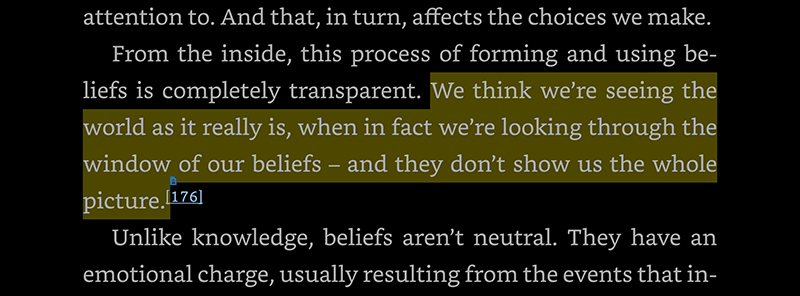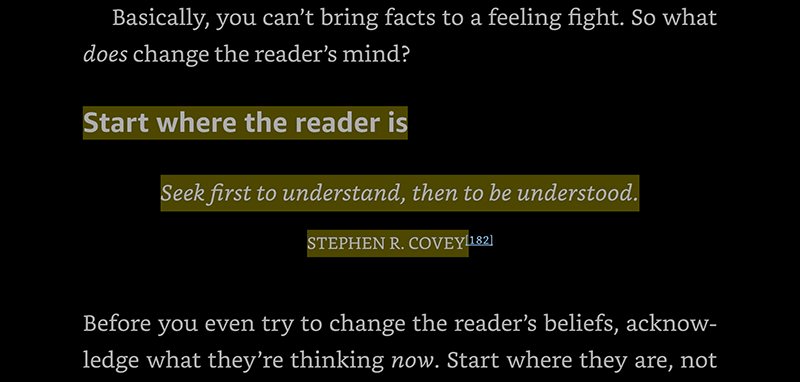Storing quotes in your Zettelkasten
In this tutorial we’re going to explore what it means to store quotes, such as book quotes or highlights from what you’re reading, within your Zettelkasten. We’ll also explore how to reference them but also how to build upon them with your own ideas from them.
Getting started
You’re reading a book and you come across a very profound quote. It’s that moment where you pause and feel like it’s telling you something very important. You want to capture it so that you can refer to it in your own thinking and your own writing.
So how do you go about doing this? There are a few things you want to consider:
- How do you capture the quote in your note taking?
- How do you reference the quote?
- How do you create an atomic note based on the quote?
- How do you use the quote for your own original thinking?
Concepts you should be familiar with
If you’re new to the Zettelkasten note-taking method, there are a few concepts which we will touch upon in this tutorial. We’ll quickly recap on these before we get started.
- Zettelkasten (or Zettelkasten method). This is the overall concept of structuring your notes with one atomic idea per note and linking them together to create an effective way to have an organic note-taking system to aid your thinking.
- Fleeting notes. These are the quick notes you capture that seem of relevance before you start to fully consider your understanding of them.
- Literature note. These are your atomic notes that help you understand the source material before merging them into your slip box as permanent notes.
- Permanent notes. These are your final atomic notes across all the books and material you’ve studied.
- Slip box. This is the place where you store your permanent notes. It may be a digital folder on your computer or a physical filing cabinet if you are hand writing your notes.
- Atomic note. This refers to notes that have one core idea expressed in them. You may see them referred to as Zettel elsewhere, which refers to a single piece of paper which has an atomic note on it.

Want a comprehensive Zettelkasten guide?
If you’re new to the Zettelkasten and want to get a comprehensive guide then do consider checking out my book Atomic Note-Taking. This book will take you from the basics right through to advanced topics with material that you can come back to for more inspiration for years to come.
When the author of the book says something that you want to capture, then you may wish to bring this into your note taking. Generally speaking this might be most highlighted from a book as you’re capturing what the author is saying.
But there is a distinction between just highlighting the ideas and highlighting the exact message they are saying. In some cases, you might want to quote the text verbatim in your note-taking as you don’t want to lose the essence of what the author is saying and how they have said it. It also gives weight to the idea as you know that others share the same viewpoint.
For example, when reading How to Write Clearly by Tom Albrighton, there is a quote which stands out:
We think we’re seeing the world as it really is, when in fact we’re looking through the window of our beliefs - and they don’t show us the whole picture.

Following the reference within the book, there is more context about it being called cognitive framing. This is where we build a series of mental filters based on biological and cultural factors that shape how we see the world.
We can use this to give us more context of how to consider this quote within our own atomic literature notes.
Then there are times where the author has a quote in the book and it really resonates with you. For example, in the same book How to Write Clearly, the author has the following quote:
Seek first to understand, then to be understood —Stephen R. Covey

I have chosen to highlight this quote because it frames such an important concept into such a simple statement. As I’m reading the book, I may decide to capture my thoughts as an annotation on the quote within my reading application so that I don’t lose the idea when I come to write up my literature notes.
For me, this statement encompasses that we all too often want to have our ideas adopted by others, but we often fail to listen first to make sure we understand. When applying this to our writing, we must establish to the reader that we understand what they are going through and their concerns before we try to share our thoughts.
Converting quotes to literature notes
We have our two quotes, now it’s time to consider how this can be carried across to our literature notes.
The goals of our literature notes
When creating our literature notes, we may want them to:
- Express our understanding of the original author’s writing
- Be able to express this as a single idea in an atomic note
- Build upon this idea in our own thinking
- Reference where the idea came from
- Structure the notes atomically so we can reuse them easily
With both examples from above, we can see how we could write our understanding within our literature notes.
Naming the quotes by its core idea
We have the following quote:
"We think we’re seeing the world as it really is, when in fact we’re looking through the window of our beliefs - and they don’t show us the whole picture"
I want to establish a name for the note that this quote will exist within. This will allow me to reference it easily and know who said it. This might be something along the lines of the following:
Now let’s look at the second quote:
"Seek first to understand, then to be understood" —Stephen R. Covey
I would try to establish a short name for this as well to help me find it when I want to reference it:
Now that we have established how to capture the quote, we can explore how to write our atomic ideas around these quotes.
Writing atomic ideas for your quotes
There are different ways to approach this. Firstly, you could write your atomic understanding as a single idea within your quote note itself, or you can create a separate note and link them together.
Atomic idea within the quote note
Let’s assume you want to write your understanding of the quote within the quote note itself.
As you can see here, the exploration of this quote is encapsulated in my own understanding and reasoning of the meaning behind it. Later we’ll explore how this can now be a jumping off point to build upon the idea.
For the second quote example, it may look like the following:
Atomic ideas as separate notes
You may wish to split the quote into its own note, and have your atomic ideas separate. Doing this has the following two advantages:
- You can express multiple ideas from a single quote
- If you encounter the same quote from multiple sources with different interpretations, you can easily merge them in your permanent notes
Let’s look at the first quote again and see how this could be split across multiple notes with internal links between them.
In the above notes, you’ll see that the single note on “cognitive framing” was the key note that other ideas could be linked to. This is how our understanding of cognitive framing on social media plays out, along with how to overcome it for better understanding.
In your own notes you may go into more detail explaining each of these core ideas. It may be helpful to include examples of where you have seen the idea play out in real life. For example, how people are quick to judge on social media where they are demonstrating that they have a narrow world view of which to frame things.
For the second quote example, we can split the note out as follows:
As you can see here with the above examples, there are a series of notes which can be created each with their own atomic ideas on them. The ‘See also’ section acts as a way to relate them together and follow the trail back to the original quote that sparked the understanding.
You can add a ‘See also’ section to the quote note itself, or use your application’s backlink search to see what notes are linking to it. You are free to choose a method that best suits you.
You can continue to expand on these notes as you wish. You could include examples of how to implement the idea on the note. For example, the note “How to pace in your writing” could include some examples of where this has been done effectively. You could then use it as a reference of how to write effectively for yourself, or teach the technique to others.
Building upon the quote’s idea
Now that you have a series of atomic literature notes which encapsulate your understanding from the quote in the original source material, you can start to consider whether you want to build upon this. Often you would do this in your permanent notes when you have merged the literature notes into your slip box. But if you feel inspired purely based on what you have been thinking about in your literature notes, then feel free to capture the idea in its own literature note.
For the purpose of this example, we can create a new note that visually illustrates what it’s like to try and be understood before we have attempted understand.
As you can see with this example, a new idea formed from the original atomic notes that allow us to express visually the importance of cognitive framing and pacing in our communication.
This note could then go on to be the seedling of an article which can help teach others to become better communicators in the work that they do.
Referencing where the idea came from
At this point we’ve captured the quotes and created our atomic ideas from it, but we haven’t captured where we saw the quote.
This is where referencing the original source material within the quote note can be helpful. It then means that any note that references the quote note can credit the original source for inspiration.
Here’s an example of how to do this within your literature notes.
To achieve this I located the page number using highlights from the Amazon Kindle reader. I then used Chat GPT to format the citation based on the book’s information:
The same method can be applied to the second quote:
You can of course choose different reference styles, or if you have a digital link, include that with the exact location of where it was mentioned. For example, for YouTube videos, you could link to the exact timecode of where it was mentioned.
Referencing who said the quote
Finally we want to consider who is saying the quote. We might start collecting multiple quotes from the same person, so it would be nice to know how many quotes we have, where we got them from, and how we have utilised them in our work.
This is where it is helpful to create a Person note in your note-taking and link to that note when we mention them. For example, our quote notes may look like the following:
As you can see from the above examples, you can now create separate entries for the people and their quotes and link them all together. You can expand on this to include common notes for books, publications, videos, locations, etc. This makes it easy to reference an internal note when you want to utilise that quote or reference a book without having to repeat a detailed citation over and over.
Conclusion
I hope you’ve enjoyed this walkthrough of how to take quotes from the books you’re reading and structure these into your literature notes as atomic ideas. As you build up more notes in your Zettelkasten, you will have a great collection of quotes which you can utilise in your own thinking, writing and teaching.
Meda Technologies Ltd is registered in England and Wales. Registered Company No: 4028221. Registered Office: 17 Linford Forum, Rockingham Drive, Linford Wood, Milton Keynes, Buckinghamshire MK14 6LY
This site is protected by reCAPTCHA and the Google Privacy Policy and Terms of Service apply.
We improve our products and advertising by using Microsoft Clarity to see how you use our website. By using our site, you agree that we and Microsoft can collect and use this data. Our privacy statement has more details.